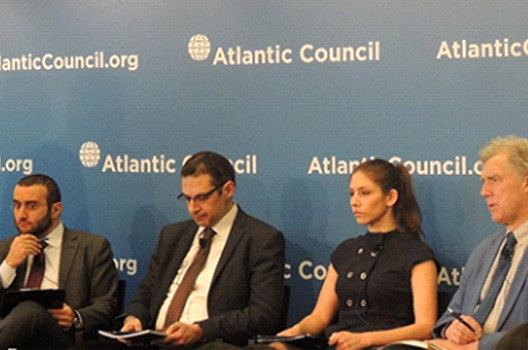 On February 10, 2016 the Atlantic Council’s Rafik Hariri Center for the Middle East hosted a panel of distinguished experts for a discussion on “Inside the Sieges: The Scope and Implications of Besieged Syria.” Hariri Center Senior Fellow Faysal Itani was joined by Syrian American Medical Society (SAMS) Protection Officer Dr. Mohamed Katoub, The Syria Institute Executive Director Valerie Szybala, and PAX Middle East Policy Lead Jan Jaap van Oosterzee to discuss the impact of sieges across Syria and future implications. Hariri Center Senior Fellow Ambassador Frederic C. Hof provided opening remarks.
On February 10, 2016 the Atlantic Council’s Rafik Hariri Center for the Middle East hosted a panel of distinguished experts for a discussion on “Inside the Sieges: The Scope and Implications of Besieged Syria.” Hariri Center Senior Fellow Faysal Itani was joined by Syrian American Medical Society (SAMS) Protection Officer Dr. Mohamed Katoub, The Syria Institute Executive Director Valerie Szybala, and PAX Middle East Policy Lead Jan Jaap van Oosterzee to discuss the impact of sieges across Syria and future implications. Hariri Center Senior Fellow Ambassador Frederic C. Hof provided opening remarks.
Hof opened the discussion with an excerpt from the International Commission of Inquiry report Out of Sight, Out of Mind: Deaths in Detention in the Syrian Arab Republic. Hof linked use of the word “extermination” in the report to the current sieges across Syria. He explained that the Geneva peace talks were meant to address humanitarian issues including sieges but were quickly suspended due to a Russian-backed regime offensive in the Aleppo countryside, and stressed that the American response has disappointed many within and outside the administration. Hof referenced Samantha Power’s book A Problem from Hell: America and the Age of Genocide, identifying a lack of US political will in stopping several genocides as a recurrent theme reasserting itself in the Syrian conflict. He closed with acknowledging that the Obama administration has not protected a single Syrian inside Syria from a regime bent on political survival through the extermination of its people.
Katoub discussed his background as a dentist from Douma, a city in the Eastern Ghouta region of Damascus, and the current situation of the besieged city. Katoub along with his wife lived in the besieged Douma until December 2014. He described life without electricity, few supplies, and barely any food or water. People adapted to this life but the society had regressed so much that children grew up without knowing about basic services like electricity. He explained challenges faced by medical workers in the besieged areas, such as UN convoys arriving to the cities with vaccinations to cover forty percent of the population–when they do arrive at all–and having to make difficult decisions on who is to receive the vaccinations.
Szybala discussed the underreporting by the United Nations on sieges in Syria. Siege Watch, a joint initiative by PAX and The Syria Institute started in December 2015, closes that gap. The report incorporates interactive maps based on data from contacts on the ground and affiliates in local councils. Regular surveys are taken to document conditions of the siege, deaths, change in access, and price fluctuations. The surveys show siege areas are also often subjected to bombing, chemical weapon attacks, and subsequent economic collapse replaced by extortion and smuggling market. The report demonstrates that the Damascus countryside, as an example, currently has over 540,000 people besieged but the United Nations only acknowledges 180,000, and the report concludes that over one million Syrians total live under siege. Szybala concluded that the sieges are manmade, getting worse, and mostly inflicted by the government.
Van Oosterzee explained that the work of Siege Watch is critical to better understand what is happening to civilians. It is important to look at the numbers, not to dehumanize the victims, but to see patterns and how sieges are a systematic weapon of war, and a policy of the Assad regime. Van Oosterzee discounted the common perception that the Syrian opposition intentionally abandoned the Geneva talks. He said the report demonstrates that the situation in Syria is worse than most even realize, and the Europe government needs to do whatever is possible to get Assad’s allies, Russia and Iran, to change the situation. He also emphasized that every time the regime approves convoys or like measures, the international community’s pressure wanes, which is a problematic trend.
View the webcast:
